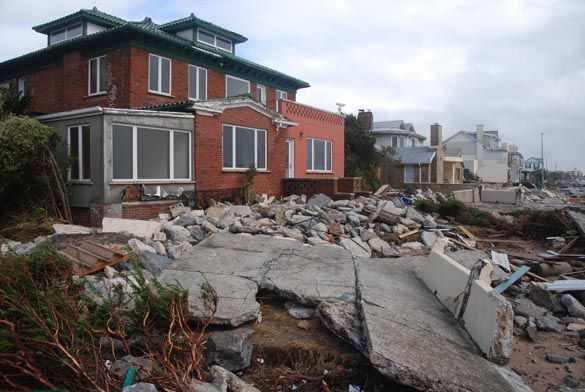Cuomo Reveals More Details Of Buyout Plan For Sandy-Damaged Homes

Governor Andrew Cuomo announced in January that he was pursuing a plan to buy Sandy-damaged homes to protect from future floods; now, more details have come out about proposed eligibility – and a promise to keep the coastline undeveloped.
The program will be funded with $400 million from the $51 billion disaster relief package approved by Congress, but the plan itself still needs federal approval. Cuomo aides made the rounds in Washington D.C. last week, pitching to officials a vision in which New York State purchases hundreds of median-sale-price homes along the coast, gives financial incentives to homeowners who move nearby, demolishes the homes, and keeps the land permanently undeveloped.
The New York Times reports:
For the 10,000 or so homes in the 100-year flood plain that were substantially damaged by Hurricane Sandy, Mr. Cuomo would offer owners the pre-storm full market value of their houses. Homeowners who chose to relocate within their home county would receive a 5 percent bonus above the market value, as part of a government effort to encourage them to stay nearby. State officials said they were planning for the possibility that 10 to 15 percent of those eligible would take the buyout.
Residents of more vulnerable areas would receive a further enticement: they would be allowed to sell their homes even if the homes suffered little, or possibly even no, damage from the hurricane, and the state would pay them an additional 10 percent bonus, above market value, to sweeten the deal.
In a few dozen blocks located in areas of extreme risk, the state would offer another 10 percent bonus if every homeowner on the block agreed to sell. Local officials would be expected to determine how best to use the new open space, though they would not be allowed to build on it.
Residents of affluent areas like Manhattan Beach, though, are unlikely to benefit – the program will only target houses at around the median home value. It remains to be seen, however, if neighbors in Sheepshead Bay, Coney Island and other Brooklyn neighborhoods should anticipate much relief, either. Details of the program are still sketchy, and it’s not yet clear whether this program will have much traction in urban communities where dense population, developed waterfronts and municipal bureaucracy present different challenges than in smaller communities like in Long Island or Staten Island, where implementation is likely to be more successful.



